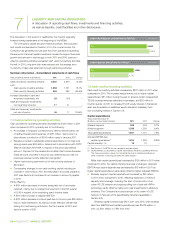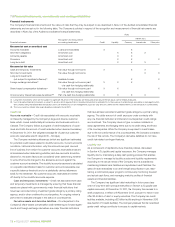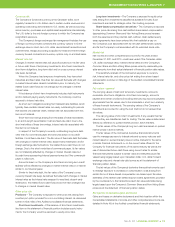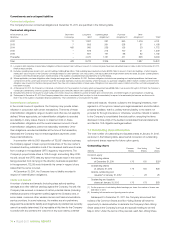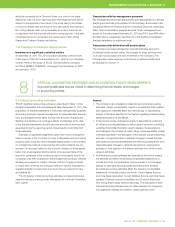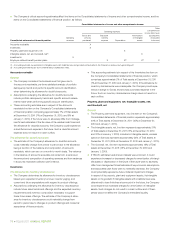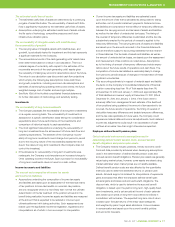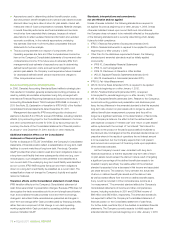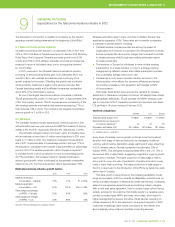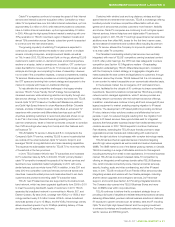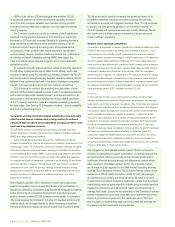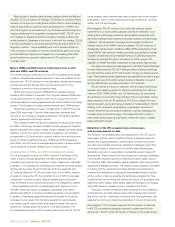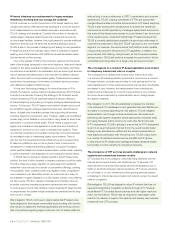Telus 2011 Annual Report Download - page 82
Download and view the complete annual report
Please find page 82 of the 2011 Telus annual report below. You can navigate through the pages in the report by either clicking on the pages listed below, or by using the keyword search tool below to find specific information within the annual report.78 . TELUS 2011 ANNUAL REPORT
.Assumptions used in determining defined benefit pension costs,
accrued pension benefit obligations and pension plan assets include:
discount rates, long-term rates of return for plan assets, market esti-
mates and rates of future compensation increases. Material changes
in overall financial performance and financial statement line items
would arise from reasonably likely changes, because of revised
assumptions to reflect updated historical information and updated
economic conditions, in the material assumptions underlying
this estimate. See Note 14 of the Audited consolidated financial
statements for further analysis.
.This accounting estimate is in respect of components of the
Operating expenses line item and Other comprehensive income line
item on the Company’s Consolidated statements of income and other
comprehensive income. If the future were to adversely differ from
management’s best estimate of assumptions used in determining
defined benefit pension costs, accrued benefit obligations and
pension plan assets, the Company could experience future increased
(or decreased) defined benefit pension expense and charges to
Other comprehensive income.
8.2 Accounting policy developments
In 2006, Canada’s Accounting Standards Board ratified a strategic plan
that resulted in Canadian generally accepted accounting principles, as
used by publicly accountable enterprises, being fully converged with
International Financial Reporting Standards as issued by the International
Accounting Standards Board. TELUS adopted IFRS-IASB on January 1,
2011. See Note 25, Explanation of transition to IFRS-IASB, of the Audited
consolidated financial statements dated December 31, 2011.
Management discussed its IFRS accounting policy choices and
elections in Section 8.2 of TELUS’ annual 2010 MD&A, including transi tion
effects: (i) by accounting topic for the Consolidated statement of income
and other comprehensive income for 2010; (ii) by accounting topic for
summary line items of the Consolidated statements of financial position
at January 1 and December 31, 2010; and (iii) on other measures.
Additional transition effects on the Consolidated
statements of financial position
Further to disclosure in TELUS’ 2010 MD&A, the Company’s Consolidated
statements of financial position reflect a reclassification of long-term credit
facilities to current maturities of long-term debt. Previously, Canadian
GAAP provided that when a debtor used short-term obligations drawn on
a long-term credit facility that were subsequently rolled over (e.g. com-
mercial paper), such obligations were permitted to be classified as a
non-current debt if the underlying long-term credit facility was classified
as non-current. IFRS-IASB requires that such short-term obligations
drawn on a long-term credit facility be classified as a current debt. The
reclassification does not change the Company’s liquidity and capital
resource measures.
Transition effects on the Consolidated statement of cash flows
IFRS transition effects on the Company’s Consolidated statement of
cash flows were limited to presentation changes. Because IFRS does not
derecognize the trade receivables sold to an arm’s-length securitization
trust, and considers the sale proceeds to be short-term borrowings,
changes in securitized trade receivables are presented as changes in
short-term borrowings within Cash provided (used) by financing activities,
rather than as a component of Net change in non-cash operating
working capital within Cash provided by operating activities under
previous Canadian GAAP.
Standards, interpretations and amendments
not yet effective and not applied
Unless otherwise indicated, the following standards are required to
be applied for periods beginning on or after January 1, 2013. Unless
other wise indicated, based upon current facts and circumstances,
the Company does not expect to be materially affected by the application
of the following standards and is currently determining which date(s)
it plans for initial compliance:
.IFRS 7, Financial Instruments: Disclosures (amended 2011).
.IFRS 9, Financial Instruments, is required to be applied for periods
beginning on or after January 1, 2015.
.Other than for the disclosure requirements therein, the following
standards and amended standards must be initially applied
concurrently:
.IFRS 10, Consolidated Financial Statements
.IFRS 11, Joint Arrangements
.IFRS 12, Disclosure of Interests in Other Entities
.IAS 27, Separate Financial Statements (amended 2011)
.IAS 28, Investments in Associates (amended 2011).
.IFRS 13, Fair Value Measurement.
.IAS 12, Income Taxes (amended 2011), is required to be applied
for periods beginning on or after January 1, 2012.
.IAS 32, Financial Instruments (amended 2011), is required
to be applied for periods beginning on or after January 1, 2014.
.IAS 19, Employee Benefits (amended 2011). Relative to the Company’s
current accounting policies and presentation and disclosure prac-
tices, the key difference in the amended standard is that the expected
long-term rate of return on plan assets will no longer be used for
defined benefit plan measurement purposes (and thus will no
longer be a significant estimate). In the determination of Net income
in the Company’s instance, the effect is that the defined benefit
plan expense concepts of “interest cost” and “return on plan assets”
will be replaced with the concept of “net interest.” Net interest for
each plan is the product of the plan’s surplus (deficit) multiplied by
the discount rate. Unchanged is that the amended standard does not
prescribe where in the results of operations the net interest amount
is to be presented, but the Company expects that it will present
such amount as a component of Financing costs upon application
of the amended standard.
As the Company’s current view, consistent with long-term
historical experience, is that the expected long-term rate of return
on plan assets would exceed the discount rate (a result of targeting
a significant percentage of the defined benefit plan assets to be
invested in equity securities), the relative effect of the amended
standard is expected to be a decrease in Net income and associated
per share amounts. The variance, if any, between the actual rate
of return on defined benefit plan assets and the discount rate,
as well as related effects from the limit on defined benefit assets,
if any, would be included in Other comprehensive income as a
“re-measurement.” The amended standard affects the Company’s
Consolidated statements of income and other comprehensive
income, including reduc tions in 2011 and 2010 Net income of
$89 million and $65 million, respectively. The amended standard is
not expected to affect the Company’s Consolidated statement of
financial position or the Consolidated statement of cash flows.
For further detail, see Note 2(b) of the Audited consolidated financial
statements. The Company currently expects to initially apply the
amended standard for periods beginning on or after January 1, 2013.


